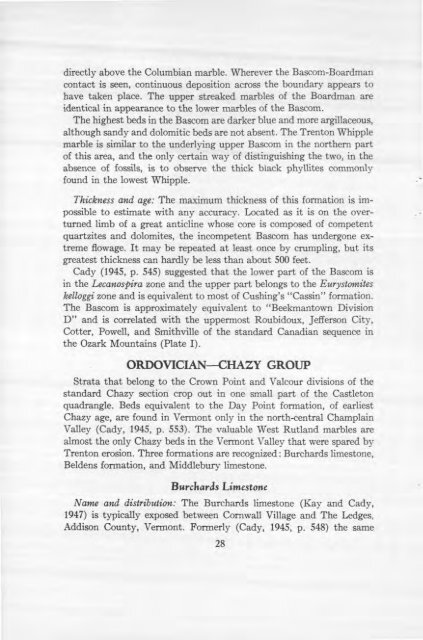STRATIGRAPHY AND STRUCTURE CASTLETON AREA VERMONT
STRATIGRAPHY AND STRUCTURE CASTLETON AREA VERMONT
STRATIGRAPHY AND STRUCTURE CASTLETON AREA VERMONT
You also want an ePaper? Increase the reach of your titles
YUMPU automatically turns print PDFs into web optimized ePapers that Google loves.
directly above the Columbian marble. Wherever the Bascom-Boardman<br />
contact is seen, continuous deposition across the boundary appears to<br />
have taken place. The upper streaked marbles of the Boardman are<br />
identical in appearance to the lower marbles of the Bascom.<br />
The highest beds in the Bascom are darker blue and more argillaceous,<br />
although sandy and dolomitic beds are not absent. The Trenton Whipple<br />
marble is similar to the underlying upper Bascom in the northern part<br />
of this area, and the only certain way of distinguishing the two, in the<br />
absence of fossils, is to observe the thick black phyllites commonly<br />
found in the lowest Whipple.<br />
Thickness and age: The maximum thickness of this formation is impossible<br />
to estimate with any accuracy. Located as it is on the overturned<br />
limb of a great anticline whose core is composed of competent<br />
quartzites and dolomites, the incompetent Bascom has undergone extreme<br />
flowage. It may be repeated at least once by crumpling, but its<br />
greatest thickness can hardly be less than about 500 feet.<br />
Cady (1945, p. 545) suggested that the lower part of the Bascom is<br />
in the Lecanospira zone and the upper part belongs to the Eurystoniites<br />
kelloggi zone and is equivalent to most of Cushing's "Cassin" formation.<br />
The Bascom is approximately equivalent to "Beekmantown Division<br />
D" and is correlated with the uppermost Roubidoux, Jefferson City,<br />
Cotter, Powell, and Smithville of the standard Canadian sequence in<br />
the Ozark Mountains (Plate I).<br />
ORDOVICIAN—CHAZY GROUP<br />
Strata that belong to the Crown Point and Valcour divisions of the<br />
standard Chazy section crop out in one small part of the Castleton<br />
quadrangle. Beds equivalent to the Day Point formation, of earliest<br />
Chazy age, are found in Vermont only in the north-central Champlain<br />
Valley (Cady, 1945, p. 553). The valuable West Rutland marbles are<br />
almost the only Chazy beds in the Vermont Valley that were spared by<br />
Trenton erosion. Three formations are recognized: Burchards limestone,<br />
Beldens formation, and Middlebury limestone.<br />
Burchards Limestone<br />
Name and distribution: The Burchards limestone (Kay and Cady,<br />
1947) is typically exposed between Cornwall Village and The Ledges,<br />
Addison County, Vermont. Formerly (Cady, 1945, p. 548) the same<br />
28













